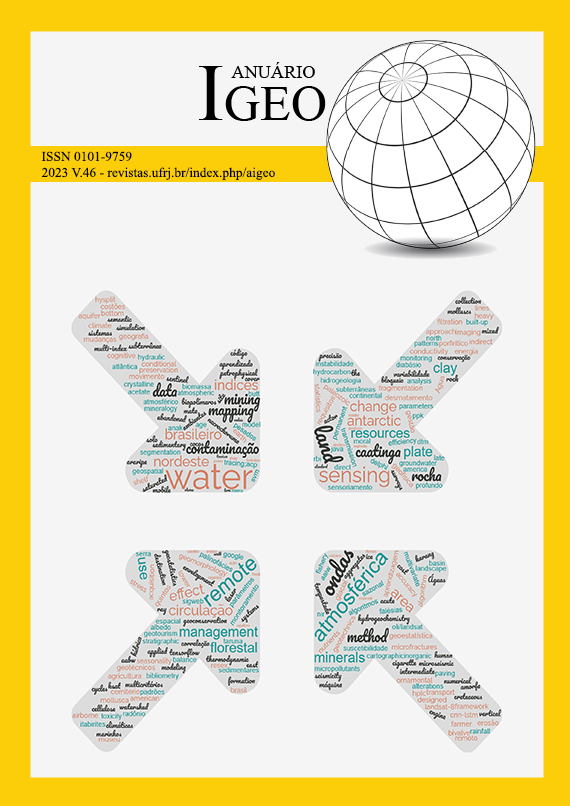Classification of Urban Solid Waste Collected with the Use of Ecobarriers in Watercourses in the Municipality of Caçapava do Sul, RS
DOI:
https://doi.org/10.11137/1982-3908_2023_46_53888Keywords:
NBR 10004/2004, Recycling, Water ResourcesAbstract
Urban solid waste is a serious problem in cities when disposed in inappropriate places or when there is a deficiency in its collection, which can cause several environmental problems. In periods of rain, these problems become more evident when these residues are transported to drainage networks and water courses, accumulating and creating obstacles to the flow, causing floods, floods, etc. In this regard, this work aimed to collect and classify urban solid waste in two water courses in the municipality of Caçapava do Sul, an ecological barrier made with recyclable materials called Ecobarrier, placed across water courses in order to retain floating waste that is transported by water. As a result, the vast majority of residues retained in the eco-barriers correspond to the category of organic matter, this is due to the vegetation around the water bodies studied, followed by the plastic, metal and textile category respectively. Thus, it can be seen that the presence of floating garbage in the water courses of the municipality partially reflects the lack of concern on the part of the population and governments with its effects on human and environmental health. It is in this context, to avoid the generation of floating waste, that the integration of public policies can play a fundamental role, with the help of environmental education.
Downloads
References
ABNT – Associação Brasileira de Normas Técnicas 2004, NBR 1004: Resíduos Sólidos: Classificação, Rio de Janeiro, ABNT.
Al-Salem, S.M., Al-Nasser, A. & Al-Dhafeeri, A.T. 2018, ‘Multi-variable regression analysis for the solid waste generation in the State of Kuwait’, Process Safety and Environmental Protection, vol. 119, pp. 172-80, DOI:10.1016/j.psep.2018.07.017.
Bernardino, D. & Franz, B. 2016, ‘Lixo flutuante na Baía de Guanabara: Passado, presente e perspectivas para o futuro’, Desenvolvimento e Meio Ambiente, vol. 38, pp. 231-52, DOI:10.5380/dma.v38i0.47024.
Borba, W.F. 2019, ‘Avaliação da contaminação ambiental em um aterro sanitário de pequeno porte, sem utilização de geomembrana, na região noroeste do Estado do Rio Grande do Sul’, PhD thesis, Universidade Federal de Santa Maria, Santa Maria.
Brasil 2010. Lei nº. 12.305, de 2 de agosto de 2010, Institui a Política Nacional de Resíduos Sólidos, Presidência da República, viewed 15 October 2018, <http://www.planalto.gov.br/ccivil_03/_ato2007-2010/2010/lei/l12305.htm>.
Brasil 2012, Lei nº 12.651, de 25 de maio de 2012, Institui Novo Lei Código Florestal, Ministério do Meio Ambiente e Mudança do Clima, viewed 20 November 2018, https://www.planalto.gov.br/ccivil_03/_ato2011-2014/2012/lei/l12651.htm.
CPRM – Companhia de Pesquisa de Recursos Minerais 2010, Companhia de Pesquisa de Recursos Minerais, viewed 20 May 2018, <http://geosgb.cprm.gov.br/>.
EMBRAPA – Empresa Brasileira de Pesquisa Agropecuária 2010, Empresa Brasileira de Pesquisa Agropecuária, viewed 8 June 2018, <http://www.cnpsa.embrapa.br/meteor/>.
Franz, B. 2011, ‘O lixo flutuante em regiões metropolitanas costeiras no âmbito de políticas públicas: O caso da cidade do Rio de Janeiro’, PhD thesis, Universidade Federal do Rio de Janeiro, Rio de Janeiro.
Forgiarini, G. M. 2018. ‘Classificação dos resíduos sólidos urbanos coletados com o uso de ecobarreira em cursos de água no município de Caçapava do Sul, RS’, viewed 24 October 2023, <https://dspace.unipampa.edu.br/bitstream/riu/4123/1/Gabriel%20Melo%20Forgiarini%202018.pdf>.
Gava, T. & Finotti, A.R. 2012, ‘Resíduos sólidos urbanos na rede de drenagem da bacia hidrográfica do rio do meio, Florianópolis/SC’, Revista de Gestão Ambiental e Sustentabilidade, vol. 1, no. 2, pp. 80-102, DOI:10.5585/geas.v1i2.24.
GOOGLE EARTH PRO 2018, Software Google Earth, versão 7.1.8.3036.
IBGE – Instituto Brasileiro de Geografia e Estatística 2010, Censo 2010, viewed 20 November 2018, <https://ww2.ibge.gov.br/home/estatistica/populacao/censo2010/familias_e_domicilios/default_familias_e_domicilios.shtm>.
Khan, D., Kumar, D. & Samadder, S. R. 2016, ‘Impact of socioeconomic status on municipal solid waste generation rate’, Waste Management, vol. 49, pp. 15-25, DOI:10.1016/j.wasman.2016.01.019.
Neves, M.G.F.P. & Tucci, C.E.M. 2008, ‘Resíduos sólidos na drenagem urbana: estudo de caso’, Revista Brasileira de Recursos Hídricos, vol. 13, no. 4, pp. 43-53, DOI:10.21168/rbrh.v13n4.p43-53.
Ribic, C.A. 1990, ‘Report of the working group on methods to assess the amount and types of marine debris’, in R.S. Shomura & M.L. Godfrey (eds), Proceedings of the second international conference on marine debris, HI, Honolulu, pp. 1201-6.
Ribic, C.A., Dixon, T.R. & Vining, I. 1992, Marine Debris Survey Manual, NOAA Technical Report, US Department of Commerce, Washington, DC.
Santos, B.M. et al. 2018, ‘Eficiência de ecobarreiras em rio dominado por maré’, viewed 18 Ouctober 2023, <https://bdm.ufpa.br:8443/jspui/bitstream/prefix/2111/1/Tcc_EficienciaEcobarreirasRio.pdf>.
Wolff, D.B., Gonçalves, I.H., Gastaldini, M.C.C. & Souza, M.M. 2016, ‘Resíduos sólidos em um sistema de drenagem urbana no município de Santa Maria (RS)’, Engenharia Sanitária e Ambiental, vol. 21, no. 1, pp. 151-8, DOI:10.1590/S1413-41520201600100132089.
Downloads
Published
How to Cite
Issue
Section
License
This journal is licensed under a Creative Commons — Attribution 4.0 International — CC BY 4.0, which permits use, distribution and reproduction in any medium, provided the original work is properly cited.















